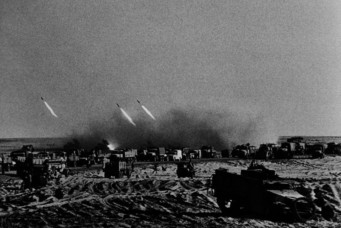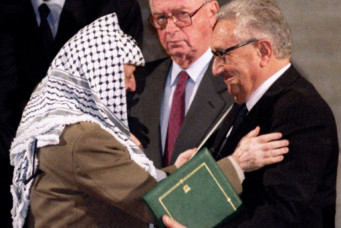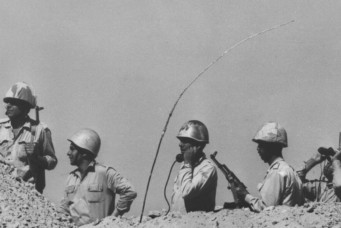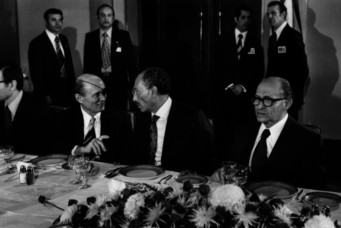United States Diplomacy and the 1973 War
Before the October 1973 War, U.S. administrations showed little interest in trying to resolve the Arab-Israeli conflict. The war was pivotal in launching U.S. diplomacy in the Middle East and kick-starting serious steps toward Egyptian-Israeli peacemaking

Former U.S. Secretary of State Henry Kissinger addresses the House Committee on International Relations in a hearing about the Middle East peace process on Capitol Hill. Kissinger left a mixed legacy in the Middle East. February 10, 2005. Ernst JME/Reuters
The 1973 Arab-Israeli War ushered in a period of active American diplomacy that contributed to two Egyptian-Israeli disengagement agreements, one Syrian-Israeli disengagement agreement, and, several years later, the Camp David Accords and the Egypt-Israel Treaty of Peace. The successes of the American efforts masked a number of significant weaknesses in concept, strategy, and tactics that would plague U.S. diplomacy in the decades that followed.
The story of the Arab-Israeli conflict can be told through “before and after” narratives of critical inflection points. The period after World War I—which witnessed the adoption of the League of Nations Mandate for Palestine—was unlike anything that preceded the Great War. The period after the 1948 war—Israel’s war of independence and Palestine’s nakba—upturned history and took the central characters of that era in an entirely different direction from what preceded. The same can be said for the June 1967 war.
In many respects, the “before and after” history of the 1973 War was different, for it involved reshaping not only the trajectories of Israeli and Egyptian politics (and, to some extent, Syrian politics as well), but it also had a monumental impact on American diplomacy, launching a period of U.S. diplomatic activity that lasted forty years. In today’s environment, in which many analysts believe the United States has “pivoted” away from the Middle East in general and from the Arab-Israeli conflict resolution process in particular, it is worth reflecting on the profound changes that were brought about by the 1973 War.
Before the 1967 War
The “before” with respect to the United States had its beginnings in the days after the ceasefire in June 1967. From 1948 until 1967, the United States was relatively uninterested in the deepening conflict between Israel and the Arab states. The United States also paid little attention to the plight of the Palestinians, who had receded from the center of regional affairs. The Truman and Eisenhower administrations suggested various schemes for repatriating a limited number of Palestinian refugees, but these ideas went nowhere.
For the United States, the 1956 Suez War was a two-fold distraction. The British-French-Israeli war was launched at the same time as the Hungarian uprising, which the U.S. administration hoped would be the beginning of the unraveling of the Soviet bloc. The war also started just days before presidential elections in the United States, when President Dwight D. Eisenhower was least interested in dealing with another international crisis.
That said, the war led to the Eisenhower Doctrine, an important element of Eisenhower’s approach to global affairs that stipulated a country could request U.S. economic or military assistance if it was threatened by aggression from another state. But the Doctrine had nothing to say about the Arab-Israeli conflict, focusing instead on regional security from the threat posed by Soviet expansion. The first test of the Doctrine came in 1958 when American forces intervened in Lebanon in response to the threat posed to a moderate regime by what was perceived as Soviet-backed radicals. Yet, other challenges in the region which did not involve the perception of a Soviet threat—for example, the Baathist revolution in Iraq and the challenge to the Jordanian monarchy by elements encouraged by Egypt’s President Gamal Abdel Nasser—went largely unheeded by the Eisenhower administration.
To be sure, Eisenhower twice dipped his toe into Arab-Israel affairs, but never jumped in all the way. Secretary of State John Foster Dulles traveled to the region carrying some ideas for advancing the prospects for peace, an effort that lingered for a bit without any success. And Eisenhower dispatched a water expert to assess whether an agreement on water sharing could serve as a basis for regional cooperation. Interestingly, that effort also failed formally, although Israel and Jordan essentially abided by the U.S.-proposed water-sharing arrangements in the decades that followed.
After the 1967 War
The change in America’s attitude, modest at first, was triggered by Israel’s overwhelming victory in 1967, defeating the armies of Egypt, Syria, and Jordan. President Lyndon B. Johnson reasoned that Israel could be induced to come to the bargaining table now that it enjoyed a position of unrivaled strength; and that the Arab states might negotiate in light of their demonstrated inability to destroy Israel by force. Johnson delivered a major speech just two weeks after the war in which he articulated five principles on which a peace settlement could be based. Five months later, these principles were enshrined in UN Security Council Resolution 242, which was to become the basis for all peacemaking efforts that followed.
Following the adoption of Resolution 242, the Johnson administration gave way to the United Nations to try and activate a peace process. Little progress was made, however, leading President Nixon’s Secretary of State William Rogers to try his hand at peacemaking in 1969, when he unveiled an outline for a comprehensive settlement. Both Israel and Egypt rejected the Rogers Plan, not only because of faults they found with it, but also due to the behind-the-scenes sabotage of the plan by Nixon’s national security adviser Henry Kissinger. Eschewing a comprehensive approach and uninterested in dealing with the conflict, Kissinger back-channeled the parties and said Nixon did not stand behind Rogers’ effort.
Part of Kissinger’s motivation derived from the myriad global challenges with which the Nixon administration was coping. The Vietnam war was raging, Nixon and Kissinger were interested in an opening to China, the seeds were being planted for détente with Russia, and Palestinian terrorism was grabbing headlines at the 1972 Olympics and in air hijackings. It was also the time when the Watergate crisis was about to unfold, leading to a drawn-out process that consumed Nixon and his presidency and left much of foreign policy in Kissinger’s hands.
Even before Watergate, in 1969, Nixon had an idea for dealing with complex crises in regions where U.S. power was being stretched. On a visit to Asia, in the context of the Vietnamization of the drawn-out war in Southeast Asia, Nixon articulated what became known as the Nixon Doctrine, seen as a means of outsourcing some American security responsibilities to local allies. In the Middle East, this role went to Iran and Israel. The effect of the Nixon Doctrine was to thin out the American presence and over time to diminish American experience and expertise in this area. The Iranians and the Israelis were expected to represent American interests—as well as their own—in the Middle East.
The War of Attrition: Kissinger’s Errors
The Egyptian-Israeli “war of attrition” between 1967 and 1970 engaged the superpowers and America’s attention. Egypt’s President Gamal Abdel Nasser appealed to the Soviet Union for advanced fighter jets, flown by Soviet pilots, to deal with Israel’s long-range bombing campaign undertaken in response to Egyptian artillery shelling of Israeli forces in Sinai. Israeli and Soviet jets tangled in the spring and summer of 1970, leading Secretary of State Rogers to negotiate a ceasefire that August. At about the same time, civil war erupted in Jordan after King Hussein clamped down on Palestinian terrorist groups that had hijacked international airliners and had them land on Jordanian soil. Kissinger made his first foray into Middle East diplomacy, trying to end the fighting before Syria could intervene against King Hussein. Nasser also worked to stop the fighting, and fatigued from the war of attrition with Israel and from his effort to mediate an end to the civil war in Jordan, died in September 1970. Anwar Sadat, Egypt’s vice president, succeeded Nasser, but everyone assessed him as weak and unlikely to last in power very long. With the immediate crisis having been solved, American attention turned away from the Arab-Israeli arena.
Kissinger was later to admit that he had underestimated Sadat, even after Sadat repulsed an effort in May 1971 to unseat him by allies of Nasser. Nixon and Kissinger did take notice when Sadat expelled most of the Soviet advisers in July 1972, and they opened a backchannel to Sadat via Egypt’s national security adviser Hafez Ismail. While Nixon was consumed with re-election politics, he was also worried about a blow-up in the Middle East. On the other hand, Kissinger was less concerned, and his two secret meetings with Ismail in 1973 led nowhere. As he was to say later, he only dealt with crises when they were hot, and in the aftermath of Sadat’s becoming president, the Arab-Israeli crisis did not appear hot.
Kissinger’s coolness toward Sadat’s initiative was supported by Israel at the time. Mordechai Gazit, a respected Israeli diplomat, analyzed Sadat’s moves after the fact and concluded that they were not to be taken seriously. It is nonetheless hard to understand just how dismissive the United States was—as well as Israel—of Sadat’s insistence that the Israeli occupation of Egyptian territory was unacceptable. Americans and others dismissed Sadat’s rhetoric that 1971 was the “year of decision,” and when 1971 came and went, it was easy to forget that the occupation remained.
It is also hard to understand how Kissinger and Israel either misunderstood or affirmatively dismissed the range of strategic changes that Sadat was instituting at the time in Egypt’s domestic and foreign policies. In addition to his insistence that the occupation of Sinai could not stand and that he was interested in a process of peacemaking, Sadat also began effecting changes in Egypt’s economy, moving away from Nasser’s disastrous “Arab socialism” to a more market-based system which he called the “infitah”, or opening.
And yet, despite all this, and because of everything else that was happening at the time, it is possible to excuse the strategic errors of Kissinger before the 1973 War. What is curious, however, was the diplomatic path chosen by Kissinger after the war.
Kissinger Comes Around
A short digression: Henry Kissinger, the U.S. Secretary of State and the National Security Adviser in the Nixon and Ford administrations, is portrayed accurately in academic literature as a brilliant master strategist and consummate diplomat. His legacy, however, remains a source of significant disagreement among historians. Some highlight his successes with the opening of U.S.–China relations, détente with the Soviet Union, and a hard-fought end of the Vietnam War. Other, less favorable, assessments attribute to him mistakes in Southeast Asia and the Indian subcontinent that contributed to tens of thousands of deaths. Most assessments agree that a high point of his diplomatic acrobatics was his diplomacy after the 1973 Arab-Israeli war that resulted in convening the Geneva peace conference, two disengagement agreements between Israel and Egypt, and a disengagement agreement between Israel and Syria.
Kissinger’s achievements are, in some respects, unique and magisterial. He brought to Washington a deep and penetrating understanding of history, in particular the statecraft and dynamics of European diplomats and their balance of power diplomacy. In the Middle East, the diplomatic agreements he shepherded paved the way for the 1979 Egyptian-Israeli peace treaty, a monumental achievement by Sadat, Prime Minister Menachem Begin, and President Jimmy Carter that reshaped the Middle East for decades to come.
Any evaluation and critique of Kissinger’s diplomacy needs to consider this vast literature regarding his statecraft. Kissinger’s achievements in the Arab-Israel arena, however, are more nuanced and less certain, with several significant questions regarding judgment, timing, strategy, and tactics that would plague American diplomacy in the decades that followed.
Between 1948 and 1967, the Arab-Israeli conflict was largely defined by Arab rejection of Israel’s existence and what the Arabs saw as the injustice suffered by the Palestinians. Following the 1967 War, however, two factors changed that. First and most importantly, the war ended with Israel occupying significant territories previously governed by Arab states. Second, the Palestinians reasserted themselves in the conflict, after almost two decades of Arab state dominance, by engaging in spectacular acts of terrorism and insisting on international recognition. For Egypt and Syria, though continuing to pay lip service to the Palestinian cause, the central element of their interests became Israel’s occupation of the Sinai Peninsula and the Golan Heights. Israel’s occupation of the West Bank, East Jerusalem, and the Gaza Strip remained on the Arab state agenda but with far less centrality.
U.S. diplomats understood the Arab concern over the occupation of their territories, but American diplomacy did not focus on this underlying cause of the perpetuation of the interstate conflict. As noted above, Kissinger dismissed Rogers’ peace plan that called for Israeli withdrawal; he paid little attention to Sadat’s initiative before the 1973 War; and, after the war, he rejected the idea of a comprehensive settlement in favor of a step-by-step, incremental approach. It took the onset of the war itself to shake Kissinger into action, but even then, his diplomacy undervalued the significance of continued Israeli occupation of Arab lands.
After the 1973 War, Kissinger assessed that Israel was not ready for a comprehensive settlement with Egypt. The step-by-step approach adopted by Kissinger met the needs of the Israeli government, but was greeted less enthusiastically by Sadat. The situation in Egypt after the war was not favorable, as the economy was in crisis, and Egypt had no benefactor, with Sadat having ousted the Soviet military before the war. Sadat wanted peace immediately as a means of unlocking the relationship with the United States. Kissinger moved slowly but persistently over many weeks in a process designed to help the Israeli government cope more easily with the required concessions.
The United States and the parties remained committed to an incremental approach for almost two decades after Kissinger introduced it during the disengagement negotiations following the October War. The Reagan Plan in 1982 tried to outline the contours of a final settlement, but it was rejected out of hand by Israel and garnered no support from the Palestinians. The 1988 Shultz Plan focused more on process and laid out some of the building blocks of what became the Madrid peace conference in 1991. Even the Oslo Accords, negotiated bilaterally between the Israelis and the Palestinians, centered on a five-year interim agreement that was supposed to lead to a final agreement by 1999. However, the accords provided no hint of what a final agreement might look like. In the years after Oslo, some Israeli and Palestinian negotiators lamented the absence in the accords of a final-status vision of two states.
There is also the question of whether the diplomacy after the 1973 War reflected a missed opportunity. Jordan did not join that war, but reportedly expressed interest in getting involved in the diplomatic process. Kissinger briefly examined the possibility of a Jordanian-Israeli interim agreement, but the gaps were too large: King Hussein wanted a 10-mile Israeli pullback from the Jordan River, while Yitzhak Rabin said Israel would hold the Jordan Valley and East Jerusalem, and Jordan could “administer” the populated parts of the West Bank.
But Kissinger was uninterested, focusing on the Egypt and Syria disengagement negotiations. Did Kissinger err in not focusing more on Jordan and the Palestinian issue? He clearly had his eye on the two Arab regional powers, Syria and Egypt, and probably believed that adding Jordan and the Palestinians to the mix would overload the political circuits in Israel. Kissinger also may have been concerned that Jordan’s interest in the West Bank and Jerusalem alone would have driven Israel from the table. At the time, there was no Palestinian track, and there is little reason to believe that outreach to the Palestinians would have made sense.
This question of Israel’s occupation of Arab territory has remained front and center ever since Kissinger’s diplomacy. But American diplomatic efforts have not made enough strides to advance a comprehensive settlement. The most recent U.S. proposal on the Palestinian track—the so-called “vision of peace” put forward by President Donald Trump—chopped up the West Bank into Palestinian sovereign cantons and ignored the negotiating history since the 1991 Madrid peace conference. Since Madrid, the parties had come close to accepting the 1967 line as the reference point for the future border between Israel and a Palestinian state, with swapped lands to account for several large Israeli settlement blocs. Trump also recognized Israeli sovereignty over the Golan Heights. The Biden administration has not reversed the Golan Heights decision and has not advanced a formal proposal to replace the Trump “vision” of peace. Perhaps most importantly, the United States has done almost nothing over the years to stop the advance of Israeli settlements, whose purpose is to assert control over all of the West Bank and East Jerusalem. American policymakers have not understood a simple reality with which the peace process must deal—it is the occupation.
Looking Back, Looking Ahead
Writing during a period of minimal U.S. activity in the Palestinian-Israeli peace process, it is easy to forget how engaged U.S. administrations were in the years after the 1973 War, but also how few promising moments resulted from American diplomacy. Even if the United States only rarely initiated a successful peace breakthrough, the most important advances in the peace process would have been impossible without active American engagement. Indeed, even when U.S. strategy or tactics did not succeed, they often stimulated movement within the region that paid dividends later. Carter’s initial preference for a U.S.-Soviet-led process stimulated Sadat to take control, and he found a willing partner in Begin. Shultz’s abortive peace plan created the groundwork for the breakthroughs at Madrid. The Camp David summit and Clinton’s parameters, far from succeeding at the time, created the conditions for peace negotiations for the decade and a half that followed.
The key issue, then, is not the brilliance of the plan or the strategy or the tactics, but rather the willingness of the leaders to invest in the effort to advance peace. If determined leaders start the engine of peacemaking, the exact route followed in the negotiations is less important than the willingness of those leaders to stay the course, adjust speed and direction, and push back against opponents and spoilers. Former U.S. Secretary of State James Baker launched his pre-Madrid diplomacy without a clear sense of where it should end, but he was determined to succeed, refusing to take no for an answer. He navigated a course between the rejectionist tendencies of Palestinian and Israeli leaders, one that would have been unthinkable without determined American leadership and staying power. Of the many lessons to be learned from the diplomacy that followed the 1973 War, this may be the most critical and far-reaching.
Daniel C. Kurtzer is S. Daniel Abraham Professor in Middle Eastern Policy Studies at Princeton University’s School of Public and International Affairs. He served as the American ambassador to Israel (2001−2005) and to Egypt (1997−2001). Instrumental in formulating and executing U.S. policy toward the Middle East peace process, he participated in the team that convened the Madrid Peace Conference in 1991. He is the co-author of The Peace Puzzle: America’s Quest for Arab-Israeli Peace, 1989-2011.
Read More



